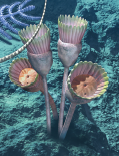Entoprocta
Entoprocta, also known as Kamptozoa, is a phylum of mostly marine, sessile, colonial animals, characterized by their unique feeding structure, the lophophore, a crown of ciliated tentacles surrounding the mouth but not the anus. The name "Entoprocta" comes from Greek, meaning "anus inside", which refers to the fact that the anus lies within the ring of tentacles, a distinctive feature differentiating them from the somewhat similar Bryozoa, with which they were once confused. Entoprocts are small, with individual zooids typically measuring less than 5 mm in size, and they are found in a variety of marine environments, from shallow coastal waters to deep sea.
Description
Entoprocts are characterized by their cup-shaped body, from which extends a stalk that attaches to a substrate or to other zooids within a colony. The body, or calyx, houses the internal organs and is crowned by the lophophore. The lophophore functions both in feeding, by creating currents to draw plankton and detritus towards the mouth, and in respiration. Entoprocts exhibit a simple level of organization, lacking a distinct head and specialized sensory organs. Their nervous system is a simple nerve net, and they have a U-shaped gut with the anus located close to the mouth, within the tentacle crown.
Reproduction and Lifecycle
Entoprocts can reproduce both sexually and asexually. Sexual reproduction involves the release of eggs and sperm into the water column, where fertilization occurs. Some species are hermaphroditic, possessing both male and female reproductive organs, while others have separate sexes. Asexually, they can reproduce through budding, where new individuals (zooids) form from the body of an existing one. The lifecycle of entoprocts includes a free-swimming larval stage, which settles onto a substrate and metamorphoses into the adult form.
Ecology
Entoprocts are found in a variety of marine environments, from tidal zones to depths of several hundred meters. They attach to hard substrates such as rocks, shells, or seaweed, and some species can even be found on other marine animals. Their feeding mechanism allows them to capture small particles, including plankton, from the water, playing a role in the aquatic food web. Entoprocts themselves are preyed upon by a variety of marine organisms, including fish and invertebrates.
Taxonomy
The phylum Entoprocta includes several hundred described species, divided among a handful of families. The taxonomy of entoprocts has been a subject of debate, with some researchers proposing that they should be classified within the larger group Lophotrochozoa, which also includes Mollusca, Annelida, and Bryozoa. This classification is based on molecular data and developmental similarities.
Conservation
While entoprocts are not typically the focus of conservation efforts, their presence and abundance can be indicators of environmental health and water quality. As sessile organisms, they are particularly susceptible to changes in their environment, including pollution and habitat destruction.
Transform your life with W8MD's budget GLP-1 injections from $125.
W8MD offers a medical weight loss program to lose weight in Philadelphia. Our physician-supervised medical weight loss provides:
- Most insurances accepted or discounted self-pay rates. We will obtain insurance prior authorizations if needed.
- Generic GLP1 weight loss injections from $125 for the starting dose.
- Also offer prescription weight loss medications including Phentermine, Qsymia, Diethylpropion, Contrave etc.
NYC weight loss doctor appointments
Start your NYC weight loss journey today at our NYC medical weight loss and Philadelphia medical weight loss clinics.
- Call 718-946-5500 to lose weight in NYC or for medical weight loss in Philadelphia 215-676-2334.
- Tags:NYC medical weight loss, Philadelphia lose weight Zepbound NYC, Budget GLP1 weight loss injections, Wegovy Philadelphia, Wegovy NYC, Philadelphia medical weight loss, Brookly weight loss and Wegovy NYC
|
WikiMD's Wellness Encyclopedia |
| Let Food Be Thy Medicine Medicine Thy Food - Hippocrates |
Medical Disclaimer: WikiMD is not a substitute for professional medical advice. The information on WikiMD is provided as an information resource only, may be incorrect, outdated or misleading, and is not to be used or relied on for any diagnostic or treatment purposes. Please consult your health care provider before making any healthcare decisions or for guidance about a specific medical condition. WikiMD expressly disclaims responsibility, and shall have no liability, for any damages, loss, injury, or liability whatsoever suffered as a result of your reliance on the information contained in this site. By visiting this site you agree to the foregoing terms and conditions, which may from time to time be changed or supplemented by WikiMD. If you do not agree to the foregoing terms and conditions, you should not enter or use this site. See full disclaimer.
Credits:Most images are courtesy of Wikimedia commons, and templates, categories Wikipedia, licensed under CC BY SA or similar.
Translate this page: - East Asian
中文,
日本,
한국어,
South Asian
हिन्दी,
தமிழ்,
తెలుగు,
Urdu,
ಕನ್ನಡ,
Southeast Asian
Indonesian,
Vietnamese,
Thai,
မြန်မာဘာသာ,
বাংলা
European
español,
Deutsch,
français,
Greek,
português do Brasil,
polski,
română,
русский,
Nederlands,
norsk,
svenska,
suomi,
Italian
Middle Eastern & African
عربى,
Turkish,
Persian,
Hebrew,
Afrikaans,
isiZulu,
Kiswahili,
Other
Bulgarian,
Hungarian,
Czech,
Swedish,
മലയാളം,
मराठी,
ਪੰਜਾਬੀ,
ગુજરાતી,
Portuguese,
Ukrainian
Contributors: Prab R. Tumpati, MD



